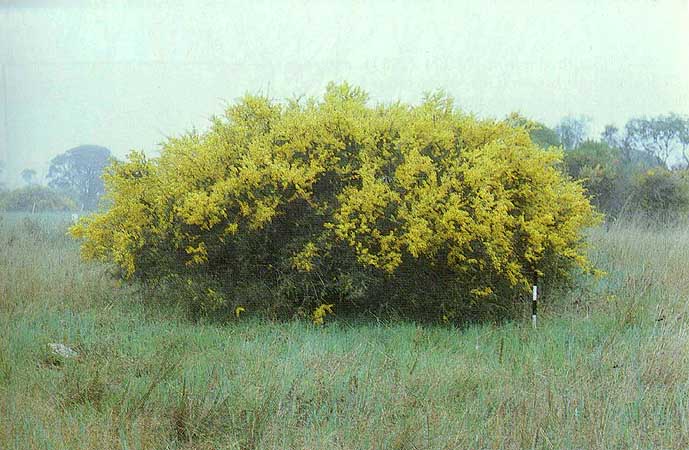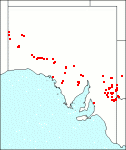Family: Fabaceae
Acacia colletioides

Citation:
G. Bentham, Hook. Lond. J. Bot. 1:336 (1842).
Derivation: Colletia (Rhamnaceae)—plant name; oides (Gr.)—resemblance.
Synonymy: Acacia nyssophylla Common name: wait-a-while
Description:
Dense, much-branched, rigid, prickly, almost glabrous, rounded, spreading shrubs 2-4 m high, often spreading more than its height; branches terete and with prominent scars of fallen phyllodes; bark grey to reddish-brown, slightly fissured at the base of stems.
Phyllodes 1-4 cm long, 1-1.5 mm diam., terete, or almost so, subulate, very rigid, pungent, spreading sometimes almost horizontal, glabrous, situated on raised phyllode bases, c. 8 prominent longitudinal veins with distinct interstices; glands small, 1-2 mm above the base.
Inflorescences axillary and solitary usually twin or sometimes in clusters up to 5 heads; flower-heads small, more or less globular, yellow, c. 15- flowered; peduncles about 1/2 as long as phyllodes, glabrous; flowers 5-merous.
Legumes narrow-oblong, 3-5 cm long, 4-5 mm broad, curved or twisted, firmly chartaceous, margins slightly constricted between seeds. Seeds longitudinal in legume, ovoid-ellipsoid; funicle filiform, short, thickened into a large yellow conical aril which half encloses the seed.
|
|
Distribution:
|
This species occurs in the North-Western, Nullarbor, Gairdner-Torrens, Eastern, Eyre Peninsula, Murray, Yorke Peninsula (northern part) and Southern Lofty regions, associated with open scrub or low woodland. Soils; brown calcareous earths, hard alkaline duplex, shallow calcareous loamy and sandy alkaline yellow duplex. Rainfall 200-350 mm. Also W.Aust., N.T., N.S.W. and Vic.
S.Aust.: NW, NU, GT, EA, EP, NL, MU.
|
Flowering time: August — October.
|

SA Distribution Map based
on current data relating to
specimens held in the
State Herbarium of South Australia
|
Biology:
No text
Related taxa:
Acacia nyssophylla (sp. 72) is very closely related and was considered a variety of A. colletioides by Bentham (1864). Acacia nyssophylla differs mainly in the phyllodes having many fine obscure closely placed veins. Acacia enterocarpa (sp. 75) can be distinguished by asperulate branches and phyllodes, also its prominently undulate legumes. Acacia rhigiophylla (sp. 96) has flattened phyllodes with 2-3 prominent veins.
Taxonomic notes:
Mistletoes recorded on A. colletioides have been Amyema preissii, wire-leaved mistletoe, by far the most common, and a single record of Lysiana exocarpi, harlequin mistletoe. However A. colletioides and A. nyssophylla have not always been critically separated and there may be confusion in the records.
Cultivation:
A rather prickly shrub, but can be quite showy when in flower. It is suitable for planting in the warmer, dry, inland areas.
Author:
Not yet available
Source:

|

